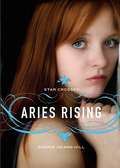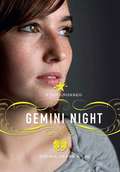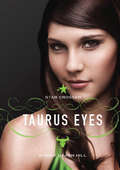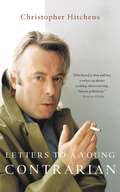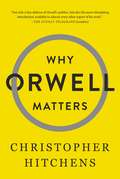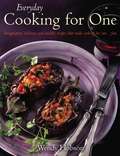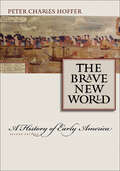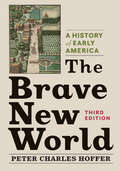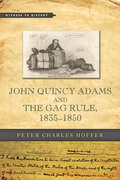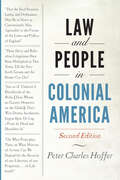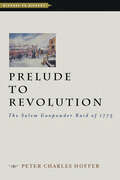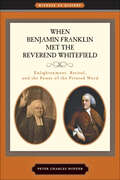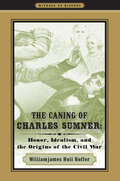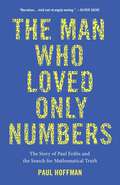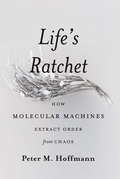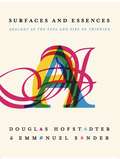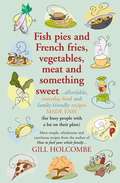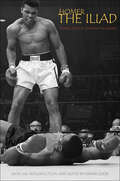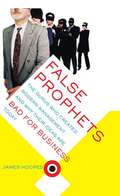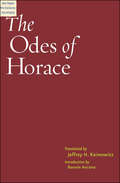- Table View
- List View
Star Crossed: Aries Rising (Star Crossed #1)
by Bonnie Hearn HillAquarius Logan McRae is a high school sophomore in Terra Bella Beach, CA and has been working all semester to impress her teachers in order to get into the summer writing camp she desperately wants to attend. But when this ordinary girl finds an extraordinary book, Fearless Astrology, her life is changed forever. Applying what she&’s learned about the zodiac, she lands her own column in the school paper and a date with the hottest guy in school!But when Logan threatens to catch the members of a secret society called The Gears, who have been vandalizing school property by reading the stars, she quickly learns that she is in over her head. Will Logan be able to catch The Gears, save her love life, keep her newspaper column, and get into the writing camp of her dreams all through the use of astrology?
Star Crossed: Aries Rising (Star Crossed #1)
by Bonnie Hearn HillAquarius Logan McRae is a high school sophomore in Terra Bella Beach, CA and has been working all semester to impress her teachers in order to get into the summer writing camp she desperately wants to attend. But when this ordinary girl finds an extraordinary book, Fearless Astrology, her life is changed forever. Applying what she's learned about the zodiac, she lands her own column in the school paper and a date with the hottest guy in school!But when Logan threatens to catch the members of a secret society called The Gears, who have been vandalizing school property by reading the stars, she quickly learns that she is in over her head. Will Logan be able to catch The Gears, save her love life, keep her newspaper column, and get into the writing camp of her dreams all through the use of astrology?
Star Crossed: Gemini Night (Star Crossed Ser.)
by Bonnie Hearn HillStarting her junior year, Logan McRae is excited about her internship at CRUSH magazine. But she is not so excited about her new boyfriend Jeremy's travel abroad in Ireland. Logan's in over her head trying to balance school, love, and friends, while trying to solve an astrological mystery -- the fate of a Gemini is star-crossed. Will Logan find out who is in danger before the CRUSH Halloween costume party? Can she prove to the publisher she deserves her own astrology column? And will her relationship with Jeremy survive the distance? Only time will tell as Logan continues to reach for the stars!
Star Crossed: Taurus Eyes
by Bonnie Hearn HillHaving been accepted into the summer writing camp in Monterey, CA, Logan worked so hard for in Aries Rising, she is on her way to becoming a real published author! She needs to impress the camp&’s instructor, Henry Jaffa, a renowned journalist, paranormal investigator, and fellow Aquarian, whom she hopes will see the promise in her writing and become her mentor.But when Logan is stuck writing about an obscure folk singer Sean Baylor, whose spirit is rumored to be haunting the quaint seaside town, she is not sure that she will be able to complete her assignment. Will Logan be able to utilize her knowledge of the planets to impress Henry Jaffa, work through her romantic tug-of-war with the camp brooding bad boy Jeremy, solve the mystery of Sean Baylor&’s death, all while competing with the overachieving writers for the coveted spots in the camp&’s anthology?
Letters to a Young Contrarian (Letters To A Young... Ser.)
by Christopher HitchensFrom bestselling author and provocateur Christopher Hitchens, the classic guide to the art of principled dissent and disagreementIn Letters to a Young Contrarian, bestselling author and world-class provocateur Christopher Hitchens inspires the radicals, gadflies, mavericks, rebels, and angry young (wo)men of tomorrow. Exploring the entire range of "contrary positions"--from noble dissident to gratuitous nag--Hitchens introduces the next generation to the minds and the misfits who influenced him, invoking such mentors as Emile Zola, Rosa Parks, and George Orwell. As is his trademark, Hitchens pointedly pitches himself in contrast to stagnant attitudes across the ideological spectrum. No other writer has matched Hitchens's understanding of the importance of disagreement--to personal integrity, to informed discussion, to true progress, to democracy itself.
Letters to a Young Contrarian
by Christopher Hitchens"Art of Mentoring" seriesIn the book that he was born to write, provocateur and best-selling author Christopher Hitchens inspires future generations of radicals, gadflies, mavericks, rebels, angry young (wo)men, and dissidents. Who better to speak to that person who finds him or herself in a contrarian position than Hitchens, who has made a career of disagreeing in profound and entertaining ways. This book explores the entire range of "contrary positions"-from noble dissident to gratuitous pain in the butt. In an age of overly polite debate bending over backward to reach a happy consensus within an increasingly centrist political dialogue, Hitchens pointedly pitches himself in contrast. He bemoans the loss of the skills of dialectical thinking evident in contemporary society. He understands the importance of disagreement-to personal integrity, to informed discussion, to true progress-heck, to democracy itself. Epigrammatic, spunky, witty, in your face, timeless and timely, this book is everything you would expect from a mentoring contrarian.
Why Orwell Matters
by Christopher Hitchens"Hitchens presents a George Orwell fit for the twenty-first century." --Boston GlobeIn this widely acclaimed biographical essay, the masterful polemicist Christopher Hitchens assesses the life, the achievements, and the myth of the great political writer and participant George Orwell. True to his contrarian style, Hitchens is both admiring and aggressive, sympathetic yet critical, taking true measure of his subject as hero and problem. Answering both the detractors and the false claimants, Hitchens tears down the façade of sainthood erected by the hagiographers and rebuts the critics point by point. He examines Orwell and his perspectives on fascism, empire, feminism, and Englishness, as well as his outlook on America, a country and culture toward which he exhibited much ambivalence. Whether thinking about empires or dictators, race or class, nationalism or popular culture, Orwell's moral outlook remains indispensable in a world that has undergone vast changes in the seven decades since his death. Combining the best of Hitchens' polemical punch and intellectual elegance in a tightly woven and subtle argument, this book addresses not only why Orwell matters today, but how he will continue to matter in a future, uncertain world.
Everyday Cooking For One: Imaginative, Delicious and Healthy Recipes That Make Cooking for One ... Fun
by Wendy HobsonLiving on your own doesn't mean losing out on interesting and healthy food. Nor does it haveto involve the often unreliable business of quartering recipes! Here is a collection of simple,delicious meals - specially designed for one - that will ensure you enjoy your everyday eating.You'll find useful tips for shopping and stocking your food cupboard and delicious recipes foreverything from snacks to main courses with fish, meat and vegetables. Quick, easy andeconomical, the recipes are designed to make everyday cooking exciting, and to keep your diethealthy and balanced.Some recipes just don't work in small quantities, and that could include some of yourfavourites. A unique feature of this book is the inclusion of really tasty recipes - such ascasseroles, roasts and cakes - that show you how to create four differentmeals from one singlecooking session.So you can try:Braised Tender Lamb, then reinvent it as Lamb with Mediterranean Couscous, Lamb withCrisp Courgettes and Parsnip-topped Lamb Or treat yourself to: Roast Lemon-infused Chicken, then enjoy Chicken Filo Parcels, Sweet and Sour Chickenand Chicken with Pancetta Or simply enjoy just-for-one treats such as:Caramelised Onion and Goats' Cheese PuffsSalmon Steak with Summer Vegetable Parcels Spinach and Avocado Salad with PancettaHoney-drenched Tunisian Almond CakeAuthor Wendy Hobsonhas spent a career working in and around cooking. She has written several books - including Classic 1000 Cake & Bake Recipes, Classic 1000 Recipesand The Kitchen Companion - and edited manymore. She loves being able to cook in small quantities to please herself as well as in larger amounts to share with family and friends.
The Brave New World: A History of Early America
by Peter Charles HofferThe Brave New World covers the span of early American history, from 30,000 years before Europeans ever landed on North American shores to creation of the new nation. With its exploration of the places and peoples of early America, this comprehensive, lively narrative brings together the most recent scholarship on the colonial and revolutionary eras, Native Americans, slavery, politics, war, and the daily lives of ordinary people. The revised, enlarged edition includes a new chapter carrying the story through the American Revolution, the War for Independence, and the creation of the Confederation. Additional material on the frontier, the Southwest and the Caribbean, the slave trade, religion, science and technology, and ecology broadens the text, and maps drawn especially for this edition will enable readers to follow the story more closely. The bibliographical essay, one of the most admired features of the first edition, has been expanded and brought up to date.Peter Charles Hoffer combines the Atlantic Rim scholarship with a Continental perspective, illuminating early America from all angles—from its first settlers to the Spanish Century, from African slavery to the Salem witchcraft cases, from prayer and drinking practices to the development of complex economies, from the colonies' fight for freedom to an infant nation's struggle for political and economic legitimacy. Wide-ranging in scope, inclusive in content, the revised edition of The Brave New World continues to provide professors, students, and historians with an engaging and accessible history of early North America.
The Brave New World: A History of Early America
by Peter Charles HofferA lively synthesis of early American history, now in its third edition.The Brave New World covers the entire span of early American history, from 30,000 years before Europeans landed on North American shores to the Revolutionary War. With its exploration of the places and peoples of early America, this comprehensive new edition of a classic textbook brings together the most recent scholarship on the colonial and revolutionary eras, Native Americans, slavery and the slave trade, politics, war, and the daily lives of ordinary people.In this edition, Peter Charles Hoffer incorporates the wealth of innovative work on early American history, including fresh material on• environmental history• the Dutch and French Caribbean• Indigenous societies• consumer goods• mapping• captivity tales• settler imperialism• power—who has it, who wants it, how it is expressed, and how it is opposedEmphasizing how diverse and entangled the early American imperial world was, this edition also greatly expands the geographical scope of the book. An updated bibliographic essay offering short descriptions of relevant books, articles, collections, and anthologies rounds out the volume. Wide-ranging and inclusive, The Brave New World continues to provide students, instructors, and historians with an engaging and accessible history of early North America.
John Quincy Adams and the Gag Rule, 1835–1850 (Witness to History)
by Peter Charles HofferPassed by the House of Representatives at the start of the 1836 session, the gag rule rejected all petitions against slavery, effectively forbidding Congress from addressing the antislavery issue until it was rescinded in late 1844. In the Senate, a similar rule lasted until 1850. Strongly supported by all southern and some northern Democratic congressmen, the gag rule became a proxy defense of slavery’s morality and economic value in the face of growing pro-abolition sentiment. In John Quincy Adams and the Gag Rule, 1835–1850, Peter Charles Hoffer transports readers to Washington, DC, in the period before the Civil War to contextualize the heated debates surrounding the rule. At first, Hoffer explains, only a few members of Congress objected to the rule. These antislavery representatives argued strongly for the reception and reading of incoming abolitionist petitions. When they encountered an almost uniformly hostile audience, however, John Quincy Adams took a different tack. He saw the effort to gag the petitioners as a violation of their constitutional rights. Adams’s campaign to lift the gag rule, joined each year by more and more northern members of Congress, revealed how the slavery issue promoted a virulent sectionalism and ultimately played a part in southern secession and the Civil War. A lively narrative intended for history classrooms and anyone interested in abolitionism, slavery, Congress, and the coming of the Civil War, John Quincy Adams and the Gag Rule, 1835–1850, vividly portrays the importance of the political machinations and debates that colored the age.
John Quincy Adams and the Gag Rule, 1835–1850 (Witness to History)
by Peter Charles HofferPassed by the House of Representatives at the start of the 1836 session, the gag rule rejected all petitions against slavery, effectively forbidding Congress from addressing the antislavery issue until it was rescinded in late 1844. In the Senate, a similar rule lasted until 1850. Strongly supported by all southern and some northern Democratic congressmen, the gag rule became a proxy defense of slavery’s morality and economic value in the face of growing pro-abolition sentiment. In John Quincy Adams and the Gag Rule, 1835–1850, Peter Charles Hoffer transports readers to Washington, DC, in the period before the Civil War to contextualize the heated debates surrounding the rule. At first, Hoffer explains, only a few members of Congress objected to the rule. These antislavery representatives argued strongly for the reception and reading of incoming abolitionist petitions. When they encountered an almost uniformly hostile audience, however, John Quincy Adams took a different tack. He saw the effort to gag the petitioners as a violation of their constitutional rights. Adams’s campaign to lift the gag rule, joined each year by more and more northern members of Congress, revealed how the slavery issue promoted a virulent sectionalism and ultimately played a part in southern secession and the Civil War. A lively narrative intended for history classrooms and anyone interested in abolitionism, slavery, Congress, and the coming of the Civil War, John Quincy Adams and the Gag Rule, 1835–1850, vividly portrays the importance of the political machinations and debates that colored the age.
Law and People in Colonial America
by Peter Charles HofferHow did American colonists transform British law into their own? What were the colonies' first legal institutions, and who served in them? And why did the early Americans develop a passion for litigation that continues to this day? In Law and People in Colonial America, Peter Charles Hoffer tells the story of early American law from its beginnings on the British mainland to its maturation during the crisis of the American Revolution. For the men and women of colonial America, Hoffer explains, law was a pervasive influence in everyday life. Because it was their law, the colonists continually adapted it to fit changing circumstances. They also developed a sense of legalism that influenced virtually all social, economic, and political relationships. This sense of intimacy with the law, Hoffer argues, assumed a transforming power in times of crisis. In the midst of a war for independence, American revolutionaries used their intimacy with the law to explain how their rebellion could be lawful, while legislators wrote republican constitutions that would endure for centuries.Today the role of law in American life is more pervasive than ever. And because our system of law involves a continuing dialogue between past and present, interpreting the meaning of precedent and of past legislation, the study of legal history is a vital part of every citizen's basic education. Taking advantage of rich new scholarship that goes beyond traditional approaches to view slavery as a fundamental cultural and social institution as well as an economic one, this second edition includes an extensive, entirely new chapter on colonial and revolutionary-era slave law. Law and People in Colonial America is a lively introduction to early American law. It makes for essential reading.
Law and People in Colonial America
by Peter Charles HofferHow did American colonists transform British law into their own? What were the colonies' first legal institutions, and who served in them? And why did the early Americans develop a passion for litigation that continues to this day? In Law and People in Colonial America, Peter Charles Hoffer tells the story of early American law from its beginnings on the British mainland to its maturation during the crisis of the American Revolution. For the men and women of colonial America, Hoffer explains, law was a pervasive influence in everyday life. Because it was their law, the colonists continually adapted it to fit changing circumstances. They also developed a sense of legalism that influenced virtually all social, economic, and political relationships. This sense of intimacy with the law, Hoffer argues, assumed a transforming power in times of crisis. In the midst of a war for independence, American revolutionaries used their intimacy with the law to explain how their rebellion could be lawful, while legislators wrote republican constitutions that would endure for centuries.Today the role of law in American life is more pervasive than ever. And because our system of law involves a continuing dialogue between past and present, interpreting the meaning of precedent and of past legislation, the study of legal history is a vital part of every citizen's basic education. Taking advantage of rich new scholarship that goes beyond traditional approaches to view slavery as a fundamental cultural and social institution as well as an economic one, this second edition includes an extensive, entirely new chapter on colonial and revolutionary-era slave law. Law and People in Colonial America is a lively introduction to early American law. It makes for essential reading.
Prelude to Revolution: The Salem Gunpowder Raid of 1775 (Witness to History)
by Peter Charles HofferBefore colonial Americans could declare independence, they had to undergo a change of heart. Beyond a desire to rebel against British mercantile and fiscal policies, they had to believe that they could stand up to the fully armed British soldier. Prelude to Revolution uncovers one story of how the Americans found that confidence.On April 19, 1775, British raids on Lexington Green and Concord Bridge made history, but it was an episode nearly two months earlier in Salem, Massachusetts, that set the stage for the hostilities. Peter Charles Hoffer has discovered records and newspaper accounts of a British gunpowder raid on Salem. Seeking powder and cannon hidden in the town, a regiment of British Regulars were foiled by quick-witted patriots who carried off the ordnance and then openly taunted the Regulars. The prudence of British commanding officer Alexander Leslie and the persistence of the patriot leaders turned a standoff into a bloodless triumph for the colonists. What might have been a violent confrontation turned into a local victory, and the patriots gloated as news spread of "Leslie’s Retreat."When British troops marched on Lexington and Concord on that pivotal day in April, Hoffer explains, each side had drawn diametrically opposed lessons from the Salem raid. It emboldened the rebels to stand fast and infuriated the British, who vowed never again to back down. After relating these battles in vivid detail, Hoffer provides a teachable problem in historic memory by asking why we celebrate Lexington and Concord but not Salem and why New Englanders recalled the events at Salem but then forgot their significance.Praise for the work of Peter Charles Hoffer"This book more than succeeds in achieving its goal of helping students understand and appreciate the cultural and intellectual environment of the Anglophone world."—New England Quarterly, reviewing When Benjamin Franklin Met the Reverend Whitefield"A synthetic essay of considerable grace and scope... An excellent overview of the field."—Journal of Legal History, reviewing Law and People in Colonial America
When Benjamin Franklin Met the Reverend Whitefield: Enlightenment, Revival, and the Power of the Printed Word (Witness to History)
by Peter Charles HofferIn the 1740s, two quite different developments revolutionized Anglo-American life and thought—the Enlightenment and the Great Awakening. This book takes an encounter between the paragons of each movement—the printer and entrepreneur Benjamin Franklin and the British-born revivalist George Whitefield—as an opportunity to explore the meaning of the beginnings of modern science and rationality on one hand and evangelical religious enthusiasm on the other.There are people who both represent the times in which they live and change them for the better. Franklin and Whitefield were two such men. The morning that they met, they formed a long and lucrative partnership: Whitefield provided copies of his journals and sermons, Franklin published them. So began one of the most unique, mutually profitable, and influential friendships in early American history. By focusing this study on Franklin and Whitefield, Peter Charles Hoffer defines with great precision the importance of the Anglo-American Atlantic World of the eighteenth century in American history. With a swift and persuasive narrative, Hoffer introduces readers to the respective life story of each man, examines in engaging detail the central themes of their early writings, and concludes with a description of the last years of their collaboration. Franklin’s and Whitefield’s intellectual contributions reach into our own time, making Hoffer's readable and enjoyable account of these extraordinary men and their extraordinary friendship relevant today.Also in the Witness to History seriesThe Huron-Wendat Feast of the Dead: Indian-European Encounters in Early North America by Erik R. SeemanKing Philip's War: Colonial Expansion, Native Resistance, and the End of Indian Sovereignty by Daniel R. MandellThe Caning of Charles Sumner: Honor, Idealism, and the Origins of the Civil War by Williamjames Hull HofferBloodshed at Little Bighorn: Sitting Bull, Custer, and the Destinies of Nations by Tim Lehman
The Caning of Charles Sumner: Honor, Idealism, and the Origins of the Civil War (Witness to History)
by Williamjames Hull HofferA signal, violent event in the history of the United States Congress, the caning of Charles Sumner on the Senate floor embodied the complex North-South cultural divide of the mid-nineteenth century. Williamjames Hull Hoffer's vivid account of the brutal act demonstrates just how far the sections had drifted apart and explains why the coming war was so difficult to avoid. Sumner, a noted abolitionist and gifted speaker, was seated at his Senate desk on May 22, 1856, when Democratic Congressman Preston S. Brooks approached, pulled out a gutta-percha walking stick, and struck him on the head. Brooks continued to beat the stunned Sumner, forcing him to the ground and repeatedly striking him even as the cane shattered. He then pursued the bloodied, staggering Republican senator up the Senate aisle until Sumner collapsed at the feet of Congressman Edwin B. Morgan. Colleagues of the two intervened only after Brooks appeared intent on beating the unconscious Sumner severely—and, perhaps, to death. Sumner's crime? Speaking passionately about the evils of slavery, which dishonored both the South and Brooks’s relative, Senator Andrew P. Butler. Celebrated in the South for the act, Brooks was fined only three hundred dollars, dying a year later of a throat infection. Sumner recovered and served out a distinguished Senate career until his death in 1873.Hoffer's narrative recounts the caning and its aftermath, explores the depths of the differences between free and slave states in 1856, and explains the workings of the Southern honor culture as opposed to Yankee idealism. Hoffer helps us understand why Brooks would take such great offense at a political speech and why he chose a cane—instead of dueling with pistols or swords—to meet his obligation under the South’s prevailing code of honor. He discusses why the courts meted out a comparatively light sentence. He addresses the importance of the event in the national crisis and shows why such actions are not quite as alien to today’s politics as they might at first seem.
The Man Who Loved Only Numbers: The Story of Paul Erdos and the Search for Mathematical Truth
by Paul Hoffman"A funny, marvelously readable portrait of one of the most brilliant and eccentric men in history." --The Seattle Times Paul Erdos was an amazing and prolific mathematician whose life as a world-wandering numerical nomad was legendary. He published almost 1500 scholarly papers before his death in 1996, and he probably thought more about math problems than anyone in history. Like a traveling salesman offering his thoughts as wares, Erdos would show up on the doorstep of one mathematician or another and announce, "My brain is open." After working through a problem, he'd move on to the next place, the next solution. Hoffman's book, like Sylvia Nasar's biography of John Nash, A Beautiful Mind, reveals a genius's life that transcended the merely quirky. But Erdos's brand of madness was joyful, unlike Nash's despairing schizophrenia. Erdos never tried to dilute his obsessive passion for numbers with ordinary emotional interactions, thus avoiding hurting the people around him, as Nash did. Oliver Sacks writes of Erdos: "A mathematical genius of the first order, Paul Erdos was totally obsessed with his subject--he thought and wrote mathematics for nineteen hours a day until the day he died. He traveled constantly, living out of a plastic bag, and had no interest in food, sex, companionship, art--all that is usually indispensable to a human life."The Man Who Loved Only Numbers is easy to love, despite his strangeness. It's hard not to have affection for someone who referred to children as "epsilons," from the Greek letter used to represent small quantities in mathematics; a man whose epitaph for himself read, "Finally I am becoming stupider no more"; and whose only really necessary tool to do his work was a quiet and open mind. Hoffman, who followed and spoke with Erdos over the last 10 years of his life, introduces us to an undeniably odd, yet pure and joyful, man who loved numbers more than he loved God--whom he referred to as SF, for Supreme Fascist. He was often misunderstood, and he certainly annoyed people sometimes, but Paul Erdos is no doubt missed. --Therese Littleton
Life's Ratchet: How Molecular Machines Extract Order from Chaos
by Peter M. HoffmannThe cells in our bodies consist of molecules, made up of the same carbon, oxygen, and hydrogen atoms found in air and rocks. But molecules, such as water and sugar, are not alive. So how do our cells—assemblies of otherwise &“dead&” molecules—come to life, and together constitute a living being? In Life&’s Ratchet, physicist Peter M. Hoffmann locates the answer to this age-old question at the nanoscale. The complex molecules of our cells can rightfully be called &“molecular machines,&” or &“nanobots&”; these machines, unlike any other, work autonomously to create order out of chaos. Tiny electrical motors turn electrical voltage into motion, tiny factories custom-build other molecular machines, and mechanical machines twist, untwist, separate and package strands of DNA. The cell is like a city—an unfathomable, complex collection of molecular worker bees working together to create something greater than themselves. Life, Hoffman argues, emerges from the random motions of atoms filtered through the sophisticated structures of our evolved machinery. We are essentially giant assemblies of interacting nanoscale machines; machines more amazing than can be found in any science fiction novel. Incredibly, the molecular machines in our cells function without a mysterious &“life force,&” nor do they violate any natural laws. Scientists can now prove that life is not supernatural, and that it can be fully understood in the context of science. Part history, part cutting-edge science, part philosophy, Life&’s Ratchet takes us from ancient Greece to the laboratories of modern nanotechnology to tell the story of our quest for the machinery of life.
Life's Ratchet: How Molecular Machines Extract Order from Chaos
by Peter M HoffmannLife is an enduring mystery. Yet, science tells us that living beings are merely sophisticated structures of lifeless molecules. If this view is correct, where do the seemingly purposeful motions of cells and organisms originate? In Life's Ratchet, physicist Peter M. Hoffmann locates the answer to this age-old question at the nanoscale. Below the calm, ordered exterior of a living organism lies microscopic chaos, or what Hoffmann calls the molecular storm -- specialized molecules immersed in a whirlwind of colliding water molecules. Our cells are filled with molecular machines, which, like tiny ratchets, transform random motion into ordered activity, and create the "purpose" that is the hallmark of life. Tiny electrical motors turn electrical voltage into motion, nanoscale factories custom-build other molecular machines, and mechanical machines twist, untwist, separate and package strands of DNA. The cell is like a city -- an unfathomable, complex collection of molecular workers working together to create something greater than themselves. Life, Hoffman argues, emerges from the random motions of atoms filtered through these sophisticated structures of our evolved machinery. We are agglomerations of interacting nanoscale machines more amazing than anything in science fiction. Rather than relying on some mysterious "life force" to drive them -- as people believed for centuries -- life's ratchets harness instead the second law of thermodynamics and the disorder of the molecular storm. Grounded in Hoffmann's own cutting-edge research, Life's Ratchet reveals the incredible findings of modern nanotechnology to tell the story of how the noisy world of atoms gives rise to life itself.
Surfaces and Essences: Analogy as the Fuel and Fire of Thinking
by Douglas Hofstadter Emmanuel SanderIs there one central mechanism upon which all human thinking rests? Cognitive scientists Douglas Hofstadter and Emmanuel Sander argue that there is. At this core is our incessant proclivity to take what we perceive, to abstract it, and to find resemblances to prior experiences—in other words, our ability to make analogies.In The Essence of Thought, Hofstadter and Sander show how analogy-making pervades our thought at all levels—indeed, that we make analogies not once a day or once an hour, but many times per second. Thus, analogy is the mechanism that, silently and hidden, chooses our words and phrases for us when we speak, frames how we understand the most banal everyday situation, guides us in unfamiliar situations, and gives rise to great acts of imagination.We categorize because of analogies that range from simple to subtle, and thus our categories, throughout our lives, expand and grow ever more fluid. Through examples galore and lively prose peppered, needless to say, with analogies large and small, Hofstadter and Sander offer us a new way of thinking about thinking.
Fish pies and French fries, Vegetables, Meat and Something Sweet: Affordable, everyday food and family-friendly recipes made easy
by Gill HolcombeCooking dinner on a daily basis can be tricky. Add shortage of time, lack of inspiration, spiralling food prices and a fussy little eater (or two) to the mix and it seems practically impossible. But the good news is there are still dozens of wholesome, tasty, tried and tested recipes for you and your family to enjoy without breaking the bank or spending too much time shopping and cooking. This book is full of economical, uncomplicated everyday recipes and tips for busy people everywhere - so if you've got LESS money than sense, help is at hand.
The Iliad (Johns Hopkins New Translations from Antiquity)
by HomerSing of rage, Goddess, that bane of Akhilleus,Peleus' son, which caused untold pain for Akhaians,sent down throngs of powerful spirits to Aides, war-chiefs rendered the prize of dogs and everysort of bird.Edward McCrorie’s new translation of Homer’s classic epic of the Trojan War captures the falling rhythms of a doomed Troy. McCrorie presents the sundry epithets and resonant symbols of Homer's verse style and remains as close to the Greek's meaning as research allows. The work is an epic with a flexible contemporary feel to it, capturing the wide-ranging tempos of the original. It underscores the honor of soldiers and dwells upon the machinations of Moira, each man's and woman's portion in life.Noted Homeric scholar Erwin Cook contributes a substantial introduction and extensive notes written to guide both students and general readers through relevant elements of ancient Greek history and culture. This version of the Iliad is ideal for readings and performances.
False Prophets: The Gurus Who Created Modern Management And Why Their Ideas Are Bad For Business Today
by James HoopesAccording to Jim Hoopes, the fundamental principles on which business is based-authority, power, control-are increasingly at odds with principles of life in a democratic society-freedom, equality, individualism. False Prophets critically examines the pioneering theories of the early management thinkers, such as Taylor, Follett, Mayo, and Deming, which intended to democratize corporate life yet have proved antithetical to the successful practice of business. Hoopes challenges popular management movements that followed in the wake of these thinkers and accuses today's business theorists of perpetuating bad management in the name of democratic values. He urges executives and managers to recognize the realities of corporate life and learn to apply the principles of power. He also unveils a new management agenda that will be of paramount significance to modern organizations.A rich and lively read, False Prophets provides a refreshingly new and original overview of the history of management in the larger context of the American culture, brilliantly illustrating its evolution-from the ivory tower to the shop floor.
The Odes of Horace (Johns Hopkins New Translations from Antiquity)
by Horace (Quintus Horatius Flaccus)This groundbreaking new translation of Horace’s most widely read collection of poetry is rendered in modern, metrical English verse rather than the more common free verse found in many other translations. Jeffrey H. Kaimowitz adapts the Roman poet's rich and metrically varied poetry to English formal verse, reproducing the works in a way that maintains fidelity to the tone, timbre, and style of the originals while conforming to the rules of English prosody. Each poem is true to the sense and aesthetic pleasure of the Latin and carries with it the dignity, concision, and movement characteristic of Horace’s writing. Kaimowitz presents each translation with annotations, providing the context necessary for understanding and enjoying Horace's work. He also comments on textual instability and explains how he constructed his verse renditions to mirror Horatian Latin. Horace and The Odes are introduced in lively fashion by noted classicist Ronnie Ancona.
